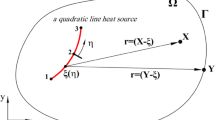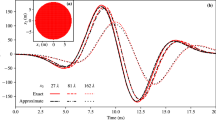Abstract
A locally conformal order-marching time-domain (OMTD) technique that accurately model curved metallic surfaces is introduced in this paper. With this technique, electromagnetic fields in the whole computation domain are presented by the regular OMTD algorithm except those near the curved metallic objects. Numerical examples have verified that a higher computation accuracy is achieved by this scheme than the conventionally used staircase approximation in the OMTD algorithm. The modeling of electrical characteristics of two millimeter-wave transmission lines is provided as examples.



Similar content being viewed by others
References
K. S. Yee, Numerical solution of initial boundary value problems involving Maxwell’s equations in isotropic media, IEEE Trans. Antennas Propag. 14, 302–307 (1966), Mar
A. Taflove and S. C. Hagness, Computational Electrodynamics: The Finite-Difference Time-Domain Method, 2nd ed. (Artech House, Boston, MA, 2000)
J. C. Bolomey, C. Durix, and D. Lesselier, Time domain integral equation approach for inhomogeneous and dispersive slab problems, IEEE Trans. Antennas Propag. 26, 658–667 (1978), Sep
J.-F. Lee, R. Lee, and A. Cangellaris, Time-domain finite-element methods, IEEE Trans. Antennas Propag. 45, 430–442 (1997), Mar
M. Krumpholz and L. P. B. Katechi, MRTD: new time-domain schemes based on multiresolution analysis, IEEE Trans. Microwave Theor. Tech. 44, 555–571 (1996), Apr
Q. H. Liu, The PSTD algorithm: a time-domain method requiring only two cells per wavelength, Microwave Opt. Tech. Lett. 14, 158–165 (1997), Oct
Y.-S. Chung, T. K. Sarkar, B. H. Jung, and M. Salazar-Palma, An Unconditionally stable scheme for the finite-difference time-domain method, IEEE Trans. Microwave Theor. Tech. 51, 697–704 (2003), Mar
W. Shao, B.-Z. Wang, X.-H. Wang, et al., An efficient compact 2-D time-domain method with weighted laguerre polynomials, IEEE Trans. Electromagn. Compat. 48, 442–448 (2006), Aug
E. A. Navarro, and V. Such, Study of TE and TM modes in waveguides of arbitrary cross-section using an FD-TD formulation, IEE Proceedings-H 139, 491–494 (1992), Dec
D. H. Choi and W. J. R. Hoefer, The finite-difference time-domain method and its application to eigenvalue problems, IEEE Trans. Microwave Theor. Tech. 34, 1464–1470 (1986), Dec
Author information
Authors and Affiliations
Corresponding author
Additional information
This work was supported by the National Natural Science Foundation of China (No. 90505001) and the CRT Program of UESTC.
Rights and permissions
About this article
Cite this article
Shao, W., Wang, BZ. & Li, H. Modeling Curved Surfaces Using Locally Conformal Order-Marching Time-Domain Method. Int J Infrared Milli Waves 28, 1033–1038 (2007). https://doi.org/10.1007/s10762-007-9281-1
Received:
Accepted:
Published:
Issue Date:
DOI: https://doi.org/10.1007/s10762-007-9281-1




